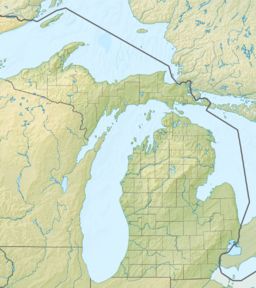| Lake Saginaw | |
|---|---|
 First Lake Saginaw - Map of Glacial lakes Whittlesey, Sagniaw and Chicago, based on the USGS Report of 1915. | |
| Location | North America |
| Group | Great Lakes |
| Coordinates | 43°55′N 83°35′W / 43.917°N 83.583°W |
| Lake type | former lake |
| Etymology | Saginaw Bay |
| Primary inflows | Laurentide Ice Sheet |
| Primary outflows | Grand River valley in Michigan |
| Basin countries | Canada United States |
| First flooded |
|
| Max. length | 70 mi (110 km) |
| Max. width | 26 mi (42 km) |
| Residence time | 100 years in existence |
| Surface elevation | 700 ft (213 m) |
| References | Chapter XV, Glacial Lake Saginaw; Frank B. Taylor; The Pleistocene of Indiana and Michigan, History of the Great Lakes; Monographs of the United States Geological Survey, Vol LIII; Frank Leverett and Frank B. Taylor; Washington, D.C,; Government Printing Office; 1915 |
Lake Saginaw occupied the basin of Saginaw Bay. There were two periods when it was an independent lake, not associated with a larger body of water in the Huron basin. The first Lake Saginaw was a contemporary of the last stages of Lake Maumee. When the ice border opened allowing these two lakes to become one, it entered the period of Lake Arkona. Then, the ice advanced, closing the link forming the second Lake Saginaw. This was during the time of Lake Whittlesey. When the ice margin retreated northward for the last time, it became the western bay of Lake Wayne and then of Lake Warren and Lake Lundy.[1] During its periods as an independent lake, its outlet was west through Grand River channel.[1]
